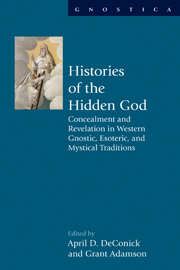 Histories of the Hidden God
Histories of the Hidden God from Part II - The Human Quest for the Hidden God
One of the works associated with Clement, a romance known as the Homilies, suggests that the teaching of Jesus who is the True Prophet and books of Peter's preaching reveal the authentic nature of God which Scripture, in fact, obscures. These striking views illumine a community behind the Pseudo-Clementine writings that has been largely lost to contemporary audiences and a perspective on the divine that we attempt to excavate through this essay. While there are other writings associated with (Pseudo-)Clement that are indebted to common sources and share key themes, we restrict our investigation of the depiction of God to the Homilies; this romance's distinctive views on Scripture and prophecy influence how the Homilies understand the divine as both concealed and revealed.
Pseudo-Clementine literature challenges our impulse to define late antique religious texts according to the heuristic categories to which we may have become accustomed; when it comes to situating the Pseudo-Clementines, we are at a loss as to how we might locate these fascinating and rich texts amid the religious landscape of late antiquity. The Pseudo-Clementines, primarily associated with fourth century Syria, have been described simultaneously as “Jewish-Christian,” “Gnostic,” and “orthodox,” however uncertain or ill-defined such designations and posited communities are. It should be no surprise, then, that the portrait of God to emerge from these writings is equally complex. For example, the deity that emerges from the Pseudo-Clementines recalls the God of the Hebrew scriptures and yet the latter writings are said to misrepresent the divine through falsehoods.
To save this book to your Kindle, first ensure [email protected] is added to your Approved Personal Document E-mail List under your Personal Document Settings on the Manage Your Content and Devices page of your Amazon account. Then enter the ‘name’ part of your Kindle email address below. Find out more about saving to your Kindle.
Note you can select to save to either the @free.kindle.com or @kindle.com variations. ‘@free.kindle.com’ emails are free but can only be saved to your device when it is connected to wi-fi. ‘@kindle.com’ emails can be delivered even when you are not connected to wi-fi, but note that service fees apply.
Find out more about the Kindle Personal Document Service.
To save content items to your account, please confirm that you agree to abide by our usage policies. If this is the first time you use this feature, you will be asked to authorise Cambridge Core to connect with your account. Find out more about saving content to Dropbox.
To save content items to your account, please confirm that you agree to abide by our usage policies. If this is the first time you use this feature, you will be asked to authorise Cambridge Core to connect with your account. Find out more about saving content to Google Drive.